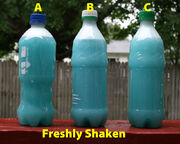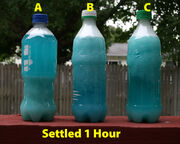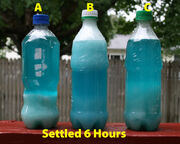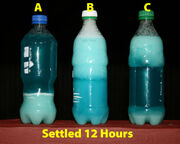| Line 42: | Line 42: | ||
Randy S. |
Randy S. |
||
===REPLY From Wiki=== |
===REPLY From Wiki=== |
||
| − | This is a topic that we have covered in the |
+ | This is a topic that we have covered in the past -- there is a series of blog entries about it. Use the search box and enter "guar concentrate" to find related articles. Short answer: guar gum does not really lend itself to eGoo-like concentrates (nor does HEC). Both of them tend to settle out if the detergent concentration is relatively high. You will see that there is a "waterless" concentrate where this does not happen, but my opinion is that that concentrate is more work than mixing it up fresh and does not work quite as well. Anyway, hopefully the blog entries will prove enlightening. There are also notes about this in the [[Guar Gum]] article. [[User:Espiegel123|Espiegel123]] ([[User talk:Espiegel123|talk]]) |
===Randy S.:=== |
===Randy S.:=== |
||
Revision as of 15:40, 9 September 2014
I am experimenting with making concentrated guar bubble juice.
While working on my experiment, I noticed something peculiar. I am wondering if anybody has any ideas about what is happening.
Background: Three different variations of the same basic recipe.
Common to all versions: 6 g. guar gum (Red Mill) -- 6 fl.oz. Dawn Pro -- 14 fl.oz. tap water.
Version A: 6 g. guar slurried in alcohol then added to bottle containing 8 oz. hot tap water then shaken until thick. -- Added 6 fl.oz. detergent. -- Topped to 20 fl.oz. water. -- 2 tsp. baking powder added. -- Capped and shaken.
Version B: 6 g. guar added to 6 fl.oz. detergent then shaken in bottle -- 2 tsp. baking powder added. -- Topped to 20 fl.oz. water. -- Capped and shaken.
Version C: 6 g. guar and 5g. baking SODA stirred into 6 fl.oz. detergent. -- 2.5g. citric acid stirred into 14 fl.oz. water. -- Acid/water added to bottle. -- Capped and shaken.
Picture 1: All bottles after being shaken appear similar in color and consistency.

Guar Juice Concentrate Freshly Made (Shaken)
Picture 2: Bottles after settling, undisturbed, for 1 hour. -- Version A has guar settling to bottom while liquid and foam floats to top. -- Versions B & C has guar floating to top.

Guar Juice Concentrate After Settling 1 Hour
Picture 3: Bottles after settling, undisturbed, for 6 hours. -- More pronnounced settling in Version A while Versions B & C continue to separate.

Guar Juice Concentrate After Settling 6 Hours
Picture 4: Bottles after settling, undisturbed, for 12 hours. -- Version A. Guar has settled completely to bottom of bottle. Cornstarch (presumed from baking powder) forms layer on top of guar. Clear, blue liquid above with sparse suds at top of bottle. -- Version B. Guar has floated to top of bottle. Cornstarch (presumed from baking powder) suspended in blue liquid at bottom of bottle. Dense suds at top of bottle. -- Version C. Guar has separated into two sections with some floating at top of bottle and some settling at bottom of bottle. Clear, blue liquid in center. Moderate suds at top of bottle.

Guar Juice Concentrate After Settling 12 Hours
Question 1: Why is this happening?
Question 2: Will this affect performance? (Have tried Version A but not Version B & C. Pending.)
Question 3: Can we use what we learned from this to create better bubble juices or concenterates?
Thanks!
Randy S.
REPLY From Wiki
This is a topic that we have covered in the past -- there is a series of blog entries about it. Use the search box and enter "guar concentrate" to find related articles. Short answer: guar gum does not really lend itself to eGoo-like concentrates (nor does HEC). Both of them tend to settle out if the detergent concentration is relatively high. You will see that there is a "waterless" concentrate where this does not happen, but my opinion is that that concentrate is more work than mixing it up fresh and does not work quite as well. Anyway, hopefully the blog entries will prove enlightening. There are also notes about this in the Guar Gum article. Espiegel123 (talk)
Randy S.:
I understand. I like operating with concentrate. A lot less to carry around. I can get water almost a where. Mixing on-site is convenient.
When I began the concentrate experiments, I expected settling. I have made and used concentrates several times. If the concentrate is reconstituted then allowed to stabilize 20-30 min before use, it works fine. Adjusting pH with sodium bicarbonate and citric acid after dilution helps.
I expected to see settling of there guar in the concentrate. If the bottle is shaken before dilution it works fine. Just give the mixture time to stabilize before use.
My question is not about settling, by itself. The question is about why there is a difference between "Version A" and the other two.
I expected to see settling as in Version A. I did not expect to see the guar floating as in Version B. I did not expect to see some of the guar floating and some of it sinking as in Version C.
The question is not about why the guar settled. The question is about why the guar settled DIFFERENTLY in each version.
Edward Replies: the layer is near neutral buoyancy -- if you shake it again and leave it it may sink or not. I have sometimes seen this with two identical bottles were shaken initially and left -- but if I shake again they usually would end up settling to the bottom.
Randy S. : That is about what I am thinking. My theory is air entrainment due to shaking/agitation.
In Version A, the guar was put in the bottle then shaken before adding soap.
In Versions B/C the soap was put into the bottle then the guar was added and the bottle was shaken. I might expect to see air entrainment and buoyancy under those conditions. What I don't understand is whether the use of baking powder in Version B versus the use of bicarbonate/citric acid in Version C had anything to do with the differences.
I made six bottles of Version A and I am using them right now. The two bottles of Version B/C will be used and tested in the next couple of days. I made up all of the bottles on Friday night and started using them Saturday afternoon. It was in the morning of Saturday when I noticed the settling. I reshook all three bottles and let them settle again. All three bottles behaved the same way after they settled again. The three pictures were taken after that second shaking.
I guess the real test is when I open those three bottles and test them to see how well the work.
Edward replies: I think that you will find that these will become hard to reconstitute if left for a week or more. See the blog articles about guar concentrates--you will find out the parameters of various failed attempts. The only shelf-stable versions that I have found have baking powder, guar and no added water. My prediction is that the added water in your concentrates (including the water in the alcohol) will gradually hydrate the guar and cause it to separate out and become a firm 'disk' that won't easily reintegrate when mixed with water. Please post your results. The only shelf-stable concentrates with guar that I have made have been on the order of 2:1 which didn't seem concentrated enough to deal with. HEC has a similar issue.
Randy S.:
I shall keep this in mind as I experiment. Currently, I shake the bottle of concentrate and the guar will break up to the consistency of tapioca grains. Mixing it with water in a 5 gal. bucket. The globules of guar begin to dissolve and mix with the solution in a few minutes. They are completely dissolved in about 20-30 minutes.
I watch the characteristics of the bubbles to monitor progress. I know the guar has dissolved when the ghosts take on a "feathery" quality. At that point, I use saturated solutions of bicarb or acid to alter the pH. I do this by watching the color profile of the bubbles and seeing how long they last. It only takes a few drops of acid/base to bring the solution into workable range. Five or six drops of acid/base are usually sufficient to bring a gallon of juice into range.
I made six bottles of concentrate like that in Version A. I have used four of them. Still have two more to use. I intend to use one more tonight if the weather is good after work.
I still have the three bottles of Versions A/B/C in the pictures which I think I will use them in head to head testing.
I'll try to report as I make more findings.
Randy: How long is the longest that one of your concentrate bottles has aged before using it?
R: Batch made on Friday night. Began to use on Saturday. Used one bottle each day since then. Still have three bottles (three days old). Will use one more tonight. Have two more after that. Also still have those three bottles in the picture sitting on the porch rail, undisturbed, since I made them.